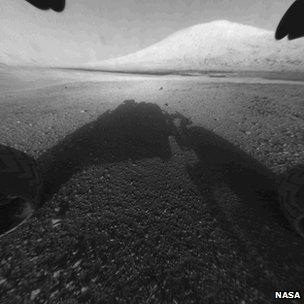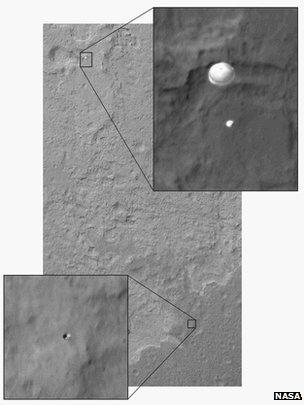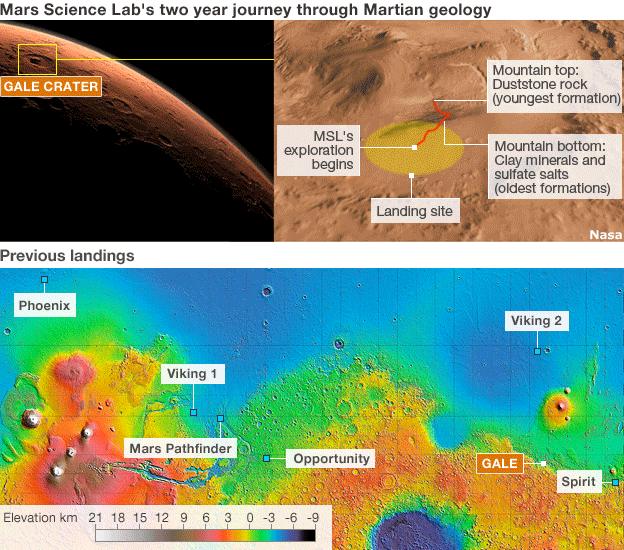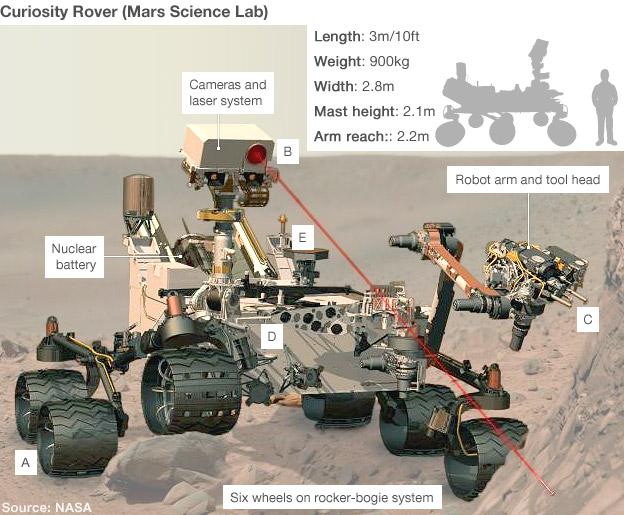Rover shoots movie during descent
- Published
Watch images taken by Nasa's Curiosity rover as it made its descent to the surface of Mars
Images that the Curiosity rover took of the surface of Mars as it made its historic descent on Monday (GMT) have now been released.
Nasa has provided almost 300 thumbnails from a sequence of pictures that will eventually be run together as a colour hi-def movie.
Visible in the timelapse, external is the heatshield discarded by the vehicle as it neared the ground.
So too is the dust kicked up by the rover's rocket-powered crane.
It was the crane that finally settled the robot on to the surface.
A signal confirming the Curiosity rover had landed on Mars was received here at mission control at the Jet Propulsion Laboratory at 05:32 GMT; 06:32 BST on Monday (22:32 PDT Sunday).
The vehicle - also known as the Mars Science laboratory (MSL) - put down in a deep equatorial depression known as Gale Crater.
Pictures from the Mars Descent Imager (Mardi), even in their thumbnail form, have now allowed engineers to work out Curiosity's precise position on the planet - a latitude of -4.5895 and a longitude of 137.4417.
The full set of high-resolution pictures from Mardi will take some weeks to downlink.
The mission team has also got its best view yet of Mount Sharp, the 5.5km-high peak sitting in the middle of Gale.
This comes from a hazard avoidance camera mounted on the lower-front of the vehicle.
Ordinarily, hazcam pictures are very wide-angle in view and therefore distorted, but image processing software has been used to correct the geometry.

The best image yet of Curiosity's ultimate quarry - the 5.5km-high Mount Sharp
The mountain is the ultimate destination for this $2.5bn (£1.6bn) mission.
Satellite data has indicated that sediments at the base of Mount Sharp were laid down in the presence of abundant water.
Curiosity, with its sophisticated suite of 10 instruments, will study those rocks to try to determine if ancient environments on Mars were ever favourable for life.
On Tuesday, Nasa released the first colour image from the ground, taken by the Mars Hand Lens Imager (Mahli) instrument. In the distance, the image shows the north wall and rim of Gale Crater.
The image is murky because it was taken through Mahli's removable dust cover which seems to be coated with debris blown onto the camera during the rover's descent.
The space agency had already shown off a spectacular shot acquired not by the rover but of the rover. This came from one of the US space agency's satellites at the Red Planet - the Mars Reconnaissance Orbiter.

MRO played a key role in Monday's landing by recording telemetry from the robot as it approached the ground.
But Nasa also tasked it with trying to get a picture of the new arrival. The rover is seen when still inside its protective shell.
Moments after this image was acquired, the vehicle would have dropped out of the capsule to ride its rocket-powered crane to the base of the crater. The resolution in the picture is such that it is even possible to pick out the discarded heatshield.
The mission team is now in its first full day of Martian operations (Sol 1). One of the key activities will be to deploy Curiosity's high-gain antenna. This unit will allow the vehicle to talk direct to Earth, in addition to relaying data via satellites like MRO.
Another action planned for Sol 1 will be to get a colour shot from the Mars Hand Lens Imager (Mahli).
This camera is mounted on the rover's tool-bearing turret at the end of its robotic arm. The picture, which should be released on Tuesday, ought to give us a real sense of being on Mars.


(A) Curiosity will trundle around its landing site looking for interesting rock features to study. Its top speed is about 4cm/s
(B) This mission has 17 cameras. They will identify particular targets, and a laser will zap those rocks to probe their chemistry
(C) If the signal is significant, Curiosity will swing over instruments on its arm for close-up investigation. These include a microscope
(D) Samples drilled from rock, or scooped from the soil, can be delivered to two hi-tech analysis labs inside the rover body
(E) The results are sent to Earth through antennas on the rover deck. Return commands tell the rover where it should drive next
Jonathan.Amos-INTERNET@bbc.co.uk and follow me on Twitter, external
- Published6 August 2012
- Published6 August 2012
- Published4 August 2012
- Published5 August 2012
- Published25 May 2012
- Published30 July 2012
- Published4 August 2012
- Published12 June 2012
- Published26 November 2011
- Published24 November 2011
- Published22 July 2011